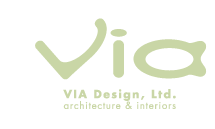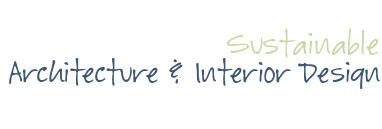

VIA Design, Ltd. Philosophy - Sustainable Design
FACT: Buildings in the United States consumed about 40% of our total energy and 60% of our electricity annually. Electricity use in the United States in 2016 was 13 times higher than in 1950. (Source: U.S. Energy Information Administration).
FACT: The construction industry is one of the major generators of waste, amounting to about 35% to 40% of material sent to landfills. An average commercial construction project in North America produces up to 2.5 pounds of solid waste for each square foot of new construction. (Source: U.S. Green Building Council).
FACT: Between 1992 and 1997 the U.S. paved over 6 million acres of farmland. This increased the urbanized land area in the United States by 47%, when population had grown only 17%. In addition to reducing the amount of prime farmland, this development impacts wildlife and plant habitat, increases surface runoff water, and creates heat island effects and light pollution. (Source: U.S. Green Building Council).
A growing trend in the design and construction industries is sustainable design. As defined by the World Commission on Environment and Development, sustainable design is “Meeting the needs of the present without compromising the ability of future generations to meet their own needs.”
Effectively considering sustainable solutions during design can reduce our environmental impact and also reduce operating costs, providing long term savings.
BIOMIMICRY
Biomimicry is an approach to innovation that seeks sustainable solutions to human challenges by emulation of nature's time-tested patterns and strategies. For example, how can a building design be informed by termites, which create housing that remains at a constant internal temperature with the use of all natural and renewable materials and passive solar orientation? How could the design of solar panels be improved with the knowledge of diatoms, which live in the upper layers of fresh and salt water, making up only 1% of the mass of living organisms yet producing 50% of the planet's photosynthesis? These and many other natural systems and processes can provide sources of inspiration for creating environmentally friendly design solutions.
NATURAL BUILDING SYSTEMS
Rather than enclosing a building and tempering the space with artificial light and mechanical systems, natural ventilation and day-lighting can be effectively utilized. Studies have shown that students and employees perform better in spaces with natural light. Other systems, such as the "Living Machine" which utilizes plants and animals to treat waste water, can also provide an aesthetic addition to a space.
ALTERNATIVE CONSTRUCTION MATERIALS & METHODS
By utilizing salvaged materials, the need for landfill space is reduced. Selecting materials with recycled content reduces solid waste and the impacts associated with extracting, harvesting and manufacturing virgin materials. For example, the "Earthship" is constructed from old tires, aluminum cans and glass bottles. Also, components such as green roofs can help insulate a building while providing natural habitat for insects and birds.

